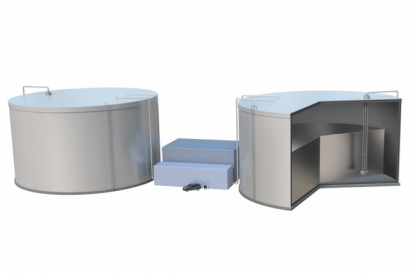
The design stores heat generated by excess electricity from solar or wind power in large tanks of white-hot molten silicon, and then converts the light from the glowing metal back into electricity when it’s needed. The researchers estimate that such a system would be vastly more affordable than lithium-ion batteries, which have been proposed as a viable, though expensive, method to store renewable energy. They also estimate that the system would cost about half as much as pumped hydroelectric storage — the cheapest form of grid-scale energy storage to date.
“Even if we wanted to run the grid on renewables right now we couldn’t, because you’d need fossil-fueled turbines to make up for the fact that the renewable supply cannot be dispatched on demand,” said Asegun Henry, the Robert N. Noyce Career Development Associate Professor in the Department of Mechanical Engineering. “We’re developing a new technology that, if successful, would solve this most important and critical problem in energy and climate change, namely, the storage problem.”
Henry and his colleagues have published their design in the journal Energy and Environmental Science.
The new storage system stems from a project in which the researchers looked for ways to increase the efficiency of concentrated solar power. Unlike conventional solar plants that use solar panels to convert light directly into electricity, CSP requires vast fields of huge mirrors that concentrate sunlight onto a central tower, where the light is converted into heat that is eventually turned into electricity.
“The reason that technology is interesting is, once you do this process of focusing the light to get heat, you can store heat much more cheaply than you can store electricity,” Henry noted.
CSP plants store solar heat in large tanks filled with molten salt, which is heated to high temperatures of about 1,000 degrees Fahrenheit. When electricity is needed, the hot salt is pumped through a heat exchanger, which transfers the salt’s heat into steam. A turbine then turns that steam into electricity.
“This technology has been around for a while, but the thinking has been that its cost will never get low enough to compete with natural gas,” Henry said. “So there was a push to operate at much higher temperatures, so you could use a more efficient heat engine and get the cost down.”
However, if operators were to heat the salt much beyond current temperatures, the salt would corrode the stainless steel tanks in which it’s stored. So Henry’s team looked for a medium other than salt that might store heat at much higher temperatures. They settled on silicon — the most abundant metal on Earth, which can withstand incredibly high temperatures of over 4,000 degrees Fahrenheit.
Last year, the team developed a pump that could withstand such blistering heat, and could conceivably pump liquid silicon through a renewable storage system. The pump has the highest heat tolerance on record — a feat that is noted in “The Guiness Book of World Records.” Since that development, the team has been designing an energy storage system that could incorporate such a high-temperature pump.
Now, the researchers have outlined their concept for a new renewable energy storage system, which they call TEGS-MPV, for Thermal Energy Grid Storage-Multi-Junction Photovoltaics. Instead of using fields of mirrors and a central tower to concentrate heat, they propose converting electricity generated by any renewable source, such as sunlight or wind, into thermal energy, via joule heating — a process by which an electric current passes through a heating element.
The system could be paired with existing renewable energy systems, such as solar cells, to capture excess electricity during the day and store it for later use. The system would consist of a large, heavily insulated, 10-meter-wide tank made from graphite and filled with liquid silicon, kept at a “cold” temperature of almost 3,500 degrees Fahrenheit. A bank of tubes, exposed to heating elements, then connects this cold tank to a second, “hot” tank. When electricity from solar cells comes into the system, this energy is converted to heat in the heating elements. Meanwhile, liquid silicon is pumped out of the cold tank and further heats up as it passes through the bank of tubes exposed to the heating elements, and into the hot tank, where the thermal energy is now stored at a much higher temperature of about 4,300 degrees Fahrenheit.
When electricity is needed the hot liquid silicon — so hot that it’s glowing white — is pumped through an array of tubes that emit that light. Specialized solar cells, known as multijunction photovoltaics, then turn that light into electricity, which can be supplied to the grid. The now-cooled silicon can be pumped back into the cold tank until the next round of storage — acting effectively as a large rechargeable battery.
The system would require tanks thick and strong enough to insulate the molten liquid within. Henry has proposed that the tanks be made out of multiple pieces of graphite, sealed in such a way as to prevent the molten liquid from leaking out. In their paper, the researchers demonstrated that they could prevent any leaks by screwing pieces of graphite together with carbon fiber bolts and sealing them with grafoil — flexible graphite that acts as a high-temperature sealant.
The researchers estimate that a single storage system could enable a small city of about 100,000 homes to be powered entirely by renewable energy.
Henry emphasizes that the system’s design is geographically unlimited, meaning that it can be sited anywhere, regardless of a location’s landscape. This is in contrast to pumped hydroelectric — currently the cheapest form of energy storage, which requires locations that can accommodate large waterfalls and dams, in order to store energy from falling water.
“This is geographically unlimited, and is cheaper than pumped hydro, which is very exciting,” Henry says. “In theory, this is the linchpin to enabling renewable energy to power the entire grid.”

